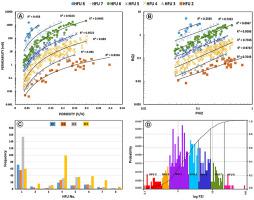Journal of Petroleum Science and Engineering ( IF 5.168 ) Pub Date : 2021-01-16 , DOI: 10.1016/j.petrol.2021.108356 Parisa Tavoosi Iraj , Hamzeh Mehrabi , Hossain Rahimpour-Bonab , Rasoul Ranjbar-Karami

|
This study integrates quantitative analysis of reservoir properties with geological parameters to discriminate the reservoir heterogeneities in the Permian–Triassic sequences of the Persian Gulf. To achieve this goal, geological analysis of core samples and thin sections were integrated with petrophysical logs and porosity–permeability data. For quantitative assessment of reservoir heterogeneity, Coefficient of Variation (CV), Dykstra-Parsons Coefficient (VDP) and Lorenz Coefficient (VLC) were used along with the concept of Hydraulic Flow Units (HFU). Depositional facies, diagenetic alterations and sequence stratigraphic framework of the reservoir were used as a basis for the interpretation of geological heterogeneities. Accordingly, 14 microfacies types and 5 facies belts have been defined and indicate a low-angle (homoclinal) ramp model. Complex diagenesis history of these sequences includes marine, hypersaline and shallow to deep burial diagenesis that considerably altered the primary distribution of reservoir properties. A comparison of tested methods revealed that the CV is the best approach for quantification of heterogeneity in targeted reservoir. Consequently, the K4 and K2 are proposed as the most homogeneous units with a dominance of grain-supported facies of shoal setting, intense effects of hypersaline dissolution and lesser effect of compaction and cementation. The K3 and K1 units show high levels of heterogeneity resulting from the combined facies changes and diagenetic alterations (dolomitization, cementation and compaction). Finally, sequence stratigraphic framework of reservoir heterogeneities is discussed for all reservoir units and can be used as a basis for ongoing reservoir studies of the Permian–Triassic sequences in the Persian Gulf and the Middle East.
中文翻译:

碳酸盐岩层序储层非均质性评价地质属性定量分析;一例来自波斯湾的二叠纪-三叠纪储层
这项研究将储层性质的定量分析与地质参数结合起来,以区分波斯湾二叠纪-三叠纪层序中的储层非均质性。为了实现这一目标,将岩心样品和薄片的地质分析与岩石物理测井和孔隙度-渗透率数据结合在一起。为了定量评估储层非均质性,变化系数(C V),Dykstra-Parsons系数(V DP)和洛伦兹系数(V LC))与液压流量单元(HFU)的概念一起使用。储层的沉积相,成岩作用和层序地层学框架被用作解释地质异质性的基础。因此,已经定义了14个微相类型和5个相带,并指示了低角度(斜向)斜坡模型。这些序列的复杂成岩作用历史包括海洋,高盐度和浅至深埋藏成岩作用,这大大改变了储层物性的主要分布。对测试方法的比较表明,C V是量化目标油藏非均质性的最佳方法。因此,K4和K2被认为是最均匀的单元,主要具有浅滩设置的颗粒支撑相,高盐溶解的强烈作用以及较小的压实和胶结作用。K3和K1单元显示出高水平的非均质性,这是由于相变和成岩作用(白云石化,胶结作用和压实作用)共同作用造成的。最后,讨论了所有储层单元的储层非均质性层序地层学框架,并可作为正在进行的波斯湾和中东二叠纪-三叠纪层序储层研究的基础。


























 京公网安备 11010802027423号
京公网安备 11010802027423号